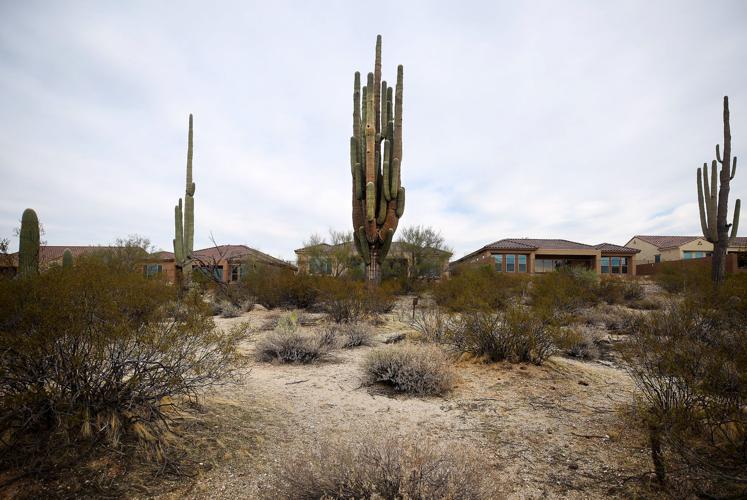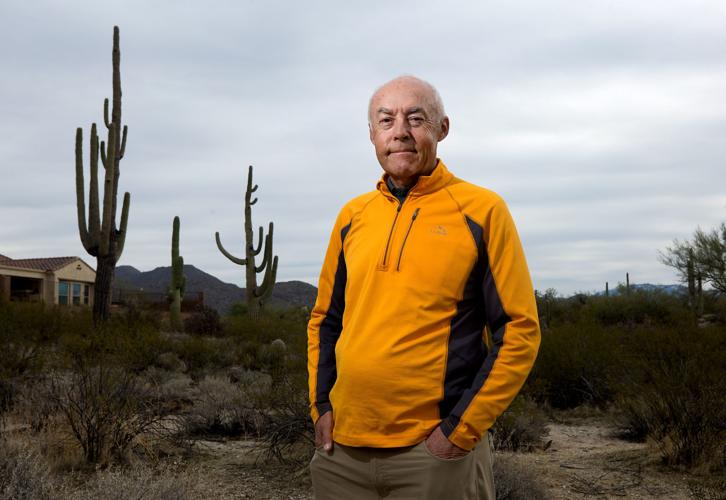Mark Johnson sat at the kitchen table in his luxurious home in the Del Webb subdivision north of Tucson. He peered out of the kitchen window and watched as four hawks landed atop “Strong Arm,” a 150-year-old saguaro that sits just past his property line in the Tortolita Preserve.
Johnson and his wife moved to the Marana subdivision from California in July, largely because of its proximity to the 2,400-acre wildlife preserve, a desert labyrinth of walking and biking trails, saguaros and washes near Dove Mountain.
“Being an avid hiker for my entire life, it was just perfect,” Johnson said. “That’s why we chose to come here – because of the Sonoran Desert and the fact that we could own a home very close to protected open space.”
Now, Johnson is one of several people concerned about its future.
The Marana Town Council met last month to discuss ending the town’s 99-year lease for the land with the Arizona State Land Department, citing escalating lease payments. State Land offered to auction off the parcel to let the town establish it as a permanent wildlife preserve, but only if the town rezoned 8,000 acres of state-owned land, including the preserve, with only some being left as open space.
Marana Mayor Ed Honea said, “We’re not going to do this and we never will.”
“The reserve is not going anywhere and it never was,” Honea said.
But that hasn’t eased the concerns of Johnson and others.
They specifically took issue with the town’s “Make Marana 2040” general plan, currently under public review, which labeled the Tortolita Preserve as a “Special Planning Area,” or land that may be developed in the future. They flooded a town planning and commission meeting last week and successfully lobbied Marana to label the area as the preserve.
They’ve branded themselves as the Tortolita Alliance. They’ve gone around town giving presentations and recruiting more than 250 subscribers to their email newsletter. They’re planning to attend the next scheduled town hearing on the general plan on Dec. 10.
“The Tortolita Preserve is a wonderful asset for the town of Marana,” Johnson said.
Paying A premium for the preserve
Johnson and his wife wanted to move to Marana after becoming familiar with the area while their son attended the University of Arizona. They found the majority of subdivisions near Dove Mountain advertised living next to the preserve, and some even charged premiums to do so.
That prompted him to do his research regarding the preserve’s future. He found previous efforts from Marana to renegotiate its lease for the property. He reached out to the town and was ensured the preserve wasn’t going anywhere.
“I felt comfortable, you know, proceeding,” Johnson said.
But his concerns grew after they moved into the home. He found the general plan without the mention of the preserve. Then he attended a community meeting that mentioned the rezoning.
“This is like a year after we were told that nothing’s going to happen,” Johnson said. “So that obviously caused a lot of consternation, not only by myself, but everybody that lives up here.”
The town signed a 99-year lease regarding the property in 2000. But it has been trying to modify it for nearly a decade.
Those concerns were brought up again during the council meeting on Oct. 8. Marana town attorney Frank Cassidy noted that the current lease payment is $575,000, but that is expected to grow to at least $2.6 million in 2099.
The State Land Department proposed a deal that would cancel the lease but also focus on the rezoning of the 8,000 acres, grant the State Land Department zoning entitlement over the land, and waive the town’s rezoning application and review fees. It also would have allowed state land to bring forward a development agreement for about 65% of the land.
“The deal from the state was just horrible,” Honea said. “I just want everyone to be comfortable with that property and that nothing is happening to that property.”
The state land official overseeing the project did not respond to an email sent earlier this week.
Preserve provides Home for pygmy owl
The potential reconfiguration of the preserve alarmed environmentalists, who noted it has long been home to a number of species, including the pygmy owl, which could soon be re-added to the endangered species list.
The Tucson-based Center for Biological Diversity said this month that it obtained an August 2021 deadline for the U.S. Fish and Wildlife Service to decide whether the owl should again be protected as an endangered species. The owl was removed in 2006.
“We’re so relieved this little owl is finally going to get another shot at desperately needed protection,” Noah Greenwald, the center’s endangered species director, said in a prepared statement. “The Sonoran Desert wouldn’t be the same without the pygmy owl stealing lizards from the desert ground and bringing them back to saguaro cavities to feed their young.”
The proposal also would have separated ecological habitats in the area from the preserve, according to Carolyn Campbell, executive director of the Coalition for Sonoran Desert Protection, who expressed those concerns to the town during the public comment portion for the general plan.
“We just want to see pieces preserved that actually function for wildlife,” Campbell said.
Planning to make Marana great
Since June 2018, Marana has been working on the Make Marana 2040 plan, a requirement of Arizona municipalities every 10 years. The document comes amidst a population and development boom in the town that is expected to continue.
“Obviously, there’s a lot more elements that are coming into play. And if we don’t take control of our own identity, we can quickly lose who Marana is or what we want to be when we grow up,” said Jason Angell, Marana’s director of development services, in October.
The more-than-150-page document includes goals and guidelines for the town’s future, including the hopes of developing the downtown area near the town municipal complex, turning Tangerine Road into a commercial corridor, and attracting jobs in the transportation and logistics sectors.
The plan was developed with public and stakeholder input, and a draft was submitted to town residents, adjacent municipalities and other public comment. Angell said the majority of the response was regarding state lands.
“It is a guiding document, if it’s approved,” Angell said. “There is flexibility because there’s eight years from now, who knows what’s going on in this community? We’re kind of crystal balling this based upon trends and things like that.”
The town is scheduled to hold a final hearing on Dec. 10. Then it goes up for voter ratification in August of next year.





